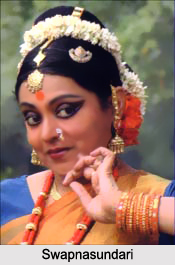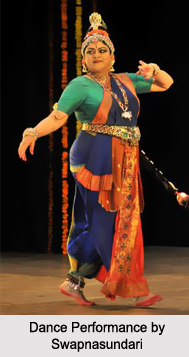 Swapnasundari was thoroughly qualified in Kuchipudi dance form and took regular lessons under the most celebrated masters like Pasumarthi Seetharamaiah and Vempati Chinna Satyam. She is a shining star among the Kuchipudi Dancers in the country. She is one of the first dancers from India who made special emphasis on the aspect presentation as well as on the musical and academic aspect of the art. That is the main reason why her dance form has actually elevated her to a cult status in the realm of Indian classical dance.
Swapnasundari was thoroughly qualified in Kuchipudi dance form and took regular lessons under the most celebrated masters like Pasumarthi Seetharamaiah and Vempati Chinna Satyam. She is a shining star among the Kuchipudi Dancers in the country. She is one of the first dancers from India who made special emphasis on the aspect presentation as well as on the musical and academic aspect of the art. That is the main reason why her dance form has actually elevated her to a cult status in the realm of Indian classical dance.
Early Life of Swapnasundari
Swapnasundari, born in Chennai, was hugely inspired by her grandmother who convinced her to learn the art of dancing. Initially she learned Bharatnatyam and Kuchipudi for nine years. Later she shifted base to Vishakapatnam with her family and trained under Pasumarthi Seetharamaiah. She took lessons in Bharatanatyam from gurus who include KN Dakshinamurthy, Adyar K Lakshmanan and B Kalyana Sundaram. Amongst various Types of Abhinayas she received quality training in Abhinaya Chandrika from the veteran teacher and performer, Kalanidhi Narayanan, who is well accepted for her mastery and genius over the aspect of histrionic, or the characteristic stylized mime, of Indian Classical Dances. When her father got transferred to Delhi for job, Swapnasundari resumed her training under her own guru Seetharamaiah who too had moved to the capital by then.
Dancing Career of Swapnasundari
Swapnasundari`s debut was a lucky accident too. It so occurred that the famous danseuse Yamini Krishnamurthy backed out of a classical performance at the last moment. The panicked show organiser, who was Swapnasundari`s neighbour as well, approached her and requested the then 15-year-old to rescue the potential catastrophe.

The debut was extraordinarily sensational, and the rest is history. The events that followed later were a series of historic shows and soon enough she had engraved a niche for herself as the flag-bearer of India`s younger generation of dancers. Today Swapnasundari has come to a point where her dedicated research in the temple dance traditions indigenous to Andhra Pradesh has resulted in the reconstruction of a nearly defunct dance genre, Vilasini Natyam.
But her creative juice expands far beyond the limitation of her profession. She was a gifted vocalist and was adept in making ancient poetry come alive with her music and dance is well known. Her stunning album, Janmabhoomi Meri Pyaari, is a proof of that talent in her. Apart from possessing good knowledge of Carnatic Music, Swapnasundari also dealt with the art of singing padams with Shrimati Mukta. This training enables her to lend a distinct character to her dance rendering of traditional padams.
Books Written by Swapnasundari
Swapnasundari was a complete creative talent and was not confined to only singing and dancing. She even delved into writing, and wrote a comprehensive encyclopaedia on dance named "The World of Koochipoodi Dance". The books looks to explore the genre of traditional dance forms along with legends and myths related with the same. The book is conventional as well as contemporary.
Swapnasundari Founded Kuchipudi Dance Cen
tre
She is the founder director of the Kuchipudi Dance Centre in New Delhi, where she trains a number of students and even produced several number ballets.
Awards Received by Swapnasundari
Honours and awards that have been conferred on Swapnasundari for her contribution to the arts are the Sahitya Kala Parishad Award and the prestigious Sangeet Natak Akademi Award from the Delhi Government and the Government of India respectively.



















